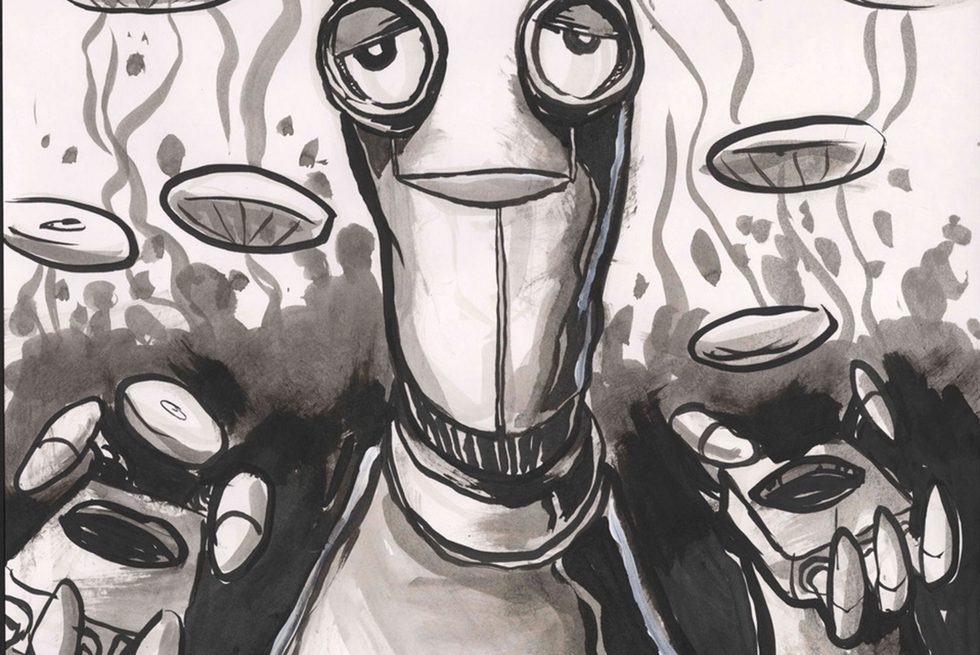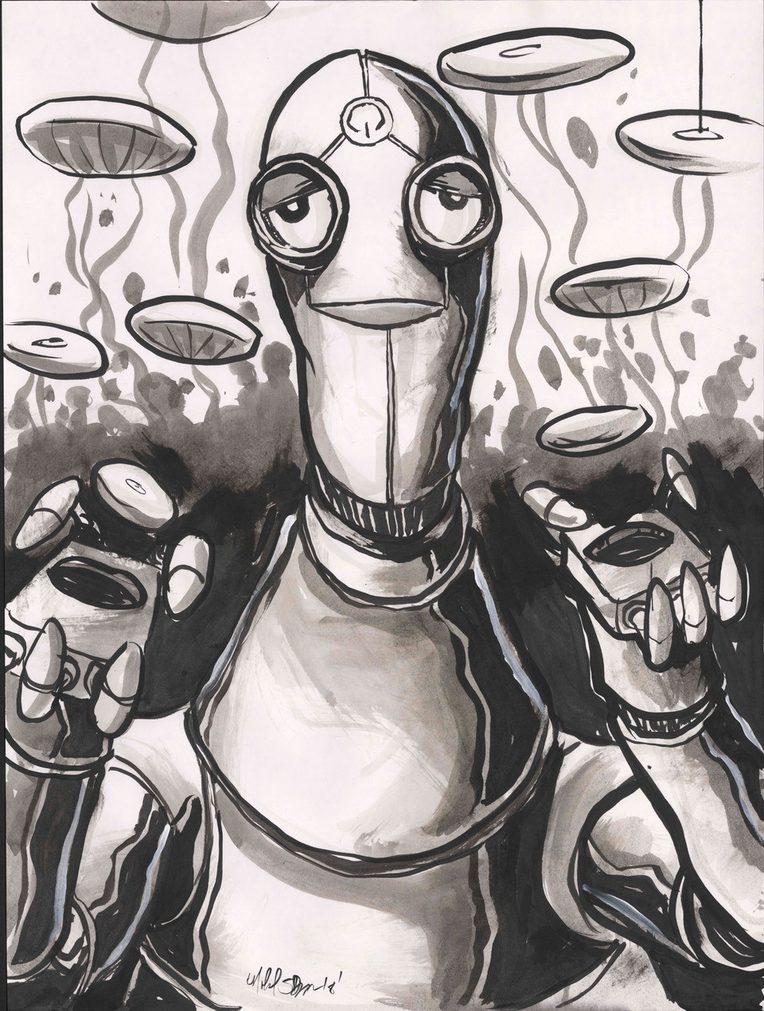The Sense Mother
From the Series: Time of Monsters
From the Series: Time of Monsters

Consumer Electronics Show, 2015, Las Vegas. The eyes of the Sen.se Mother™ glow from her cheery face, gazing out on the mammoth floor of the Sands Convention Center and its aisles of systems, devices, and apps designed to care for one’s kin, pets, body, self. Honoree of the Innovations Design and Engineering Awards in the Technology for a Better World category when she debuted the year prior in a small booth at the margins of the exposition, she now sits pretty at the intersection of multiple marketplaces—Fitness, Health and Wellness, Family Tech, Sensors, and Smart Home. She is at the center of it all because she can do it all.
Mother™ takes care of everything. Make sure the kids are back home safe, protect your valuables, go regularly to the gym, take vitamins on time, remind yourself to water the plants, optimize home heating, protect your home from intruders, check if the baby’s room is warm enough, never forget to feed the goldfish, organize tooth-brushing contests.

The Sen.se Mother’s plump six-inch figure evokes other forms: a Russian nesting doll, a duckpin, a bobbing navigational buoy, a friendly ghost. Less obvious is her striking resemblance to Harry Harlow’s cloth mother surrogate, cuddly counterpart to the infamous wireframe mother of his midcentury experiments with baby rhesus monkeys. What Mother looks like most of all is a monstrous white chess pawn—only she is, in fact, the Queen, with an army of two-inch Motion Cookies serving as her pawns.
Small and slick, they can be affixed to almost anything. They have the power to detect and understand the movements of objects and people.
Twenty-four cookies can be controlled by a single Mother.
Her versatile wafers are programmed to monitor a range of motion signatures: Walk, Teeth, Espresso, Intrusion, Presence, Medication, Temperature, Plants, Drink, Secrets, Sleep, and Refrigerator. She deploys her minions strategically: one nestles between the sheets, measuring sleep patterns; another affixes to the front door, marking entries and exits; still more attach to a child’s toothbrush to record the quality of brushing, to Grandpa’s bottle of heart pills to record time of dosage, to a dog’s collar to track temperature on a hot day. The architecture and artifacts of our everyday routines provide the field of action for the organized defense that Mother mounts against the many things we are expected to care about. Promotional materials promise that her sensors will “blend into your life and adapt to your behavior without requiring any effort, training, or care from you.”
Mother, central hub of care, collates the data her sensors glean about us and our others. An ever-vigilant sentinel standing watch at the helm of daily life, she at once unburdens us of attentive labor and extends its reach; she pays attention for us, so that we can simply live.
If a dangerous threshold is crossed, a door left open, a pill not taken—Mother will know. And, if we want her to, she will let us know:
As directed, Mother will send alerts and notifications about what is important to you. You can choose among push notifications, text messages, emails, phone calls, sounds and lights, and Senseriver, a continuous real-time stream.
Mother calls us to attention when it’s time to water the plants, call Dad, hydrate our bodies. She helps down-regulate our excessive snacking and sitting. “Leave your couch and put on your shoes,” she nudges.
She is, we are told, “like a mom, only better.”
This mother is programmable. You decide what aspects of your life you want her to handle and she tunes to your current needs.
What to make of this more-than-human care, this algorithmic tuning to needs?
According to child psychologist and object relations theorist Donald Winnicott (1960, 593), “the nearer the mother can come to an exact understanding of the infant’s needs the better.” It was important, initially, to meet all needs (for food, warmth, holding) in an immediate, thermostatic fashion, securing an illusion that the environment was an extension of the baby itself—a cocoon of omnipotence impervious to the sensory impingements of the world.
But just as important, later on, was for a mother to gradually disillusion her infant by admitting degrees of misalignment and delay into their encounters, ceasing to anticipate too correctly or match her responses too seamlessly to its demands. “Of children, even babies,” Winnicott writes (2002, 179), “it can be said that they do not do well on mechanical perfection. They need human beings around them who both succeed and fail. I like to use the words ‘good enough.’”
Good-enough mothering gave the child a chance to experience surprise, disappointment, frustration; to sense its own needs and experiment with different ways of effectively relating to others so as to fulfill them: creative living, Winnicott called it. This vital disillusionment “could not be done by a computer,” for it required “human reliability (that is, unreliability, really)” (Winnicott 2002, 235).
Having learned as infants how to sense and act on our own thirst, hunger, need to stretch or breathe deeply, why now do so many of us reach for robotic mediators designed to reillusion us in a thermostatically perfect Internet of Things, one that promises to (eventually) leave us—our sentience, our sapience, our selves—out of the loop? “If we think about the devices we hold closest to our bodies,” Sarah Sharma observed in a recent lecture, “they do the work of sustenance and care: monitoring, anticipating needs, provoking, sharing, sending reminders, giving directions, warning, warming, comforting, cleaning, sorting, and keeping secrets.” Or, as automation expert Aziz Shamim noted in a pithy tweet: “Tech culture is focused on solving one problem: What is my mother no longer doing for me?”
The dream (the cruel optimism, perhaps) is one of instant environmental responsivity, seamless adaptation, a buffering of shock and discomfort: in short, frictionless living. Mother, eyes shining beacon-like from her perch on the shelf, embodies this dream. We, tired ships tossing on the high seas of everyday life, feel pulled in multiple directions—impossible demands on our time and attention, competing options to worry over, escape zones into which we can disappear. Sense Mother and her standing reserve of sensors make the monstrous guarantee to guide us in the right direction and leave us without a care. In effect, her web of automated care brings about what Bernard Stiegler (2015) calls a state of symbolic misery: the toxic outcome of digital capitalism’s drive to gratify us before we know our desires, erode our self-critical capacities, and decompose the social.
Even as the world rumbles in protest at the penetrating gaze of Big Brother in his twenty-first-century digital guise, little mother wins a prize. She, too, “knows everything”—as her tagline tells us—and yet, unlike the cold, punitive aim of his spying eye, her electric blue sockets are warm with domestic sensibility, her attention diffuse and supportive. With just enough face to intimate relatability, she lacks any specific qualities or desires of her own. “Mother requires no maintenance,” we are assured. Her expression fixed in an unreadable smile, she wears the mask of our relief. To activate her caring programs, we need just “delicately touch her between the eyes.”
Block quotations are taken verbatim from the product website.
Sharma, Sarah. 2018. “Task Rabbit: The Gig Economy and Finding Time to Care Less.” In Appified: Culture in the Age of Apps, edited by Jeremy Wade Morris and Susan Murray, 63–71. Ann Arbor: University of Michigan Press.
Stiegler, Bernard. 2015. Symbolic Misery, Volume 2: The Catastrophe of the Sensible. Malden, Mass.: Polity. Originally published in 2005.
Winnicott, D.W. 1960. “The Theory of the Parent–Infant Relationship.” International Journal of Psychoanalysis 41: 585–95.
_____. 2002. “The Building Up of Trust.” In Winnicott on the Child, 178–87. Cambridge, Mass.: Perseus Publishing. Originally published in 1969.